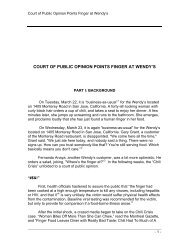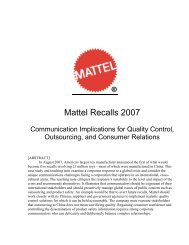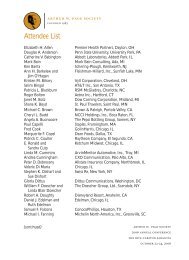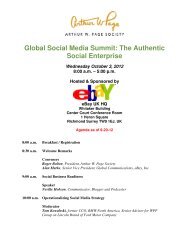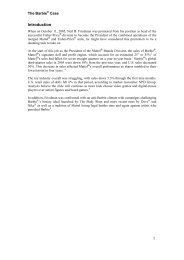The Barbie Case - The Arthur Page Society
The Barbie Case - The Arthur Page Society
The Barbie Case - The Arthur Page Society
Create successful ePaper yourself
Turn your PDF publications into a flip-book with our unique Google optimized e-Paper software.
third place<br />
David Lee, Julie Ratliff<br />
Faculty Adviser: James O’Rourke<br />
Mendoza College of Business<br />
University of Notre Dame<br />
Citigroup:<br />
Restoring Ethics and Image Before Growth<br />
Charles Prince, CEO of Citigroup, is facing a daunting<br />
challenge as the head of the largest financial services<br />
organization in world. He has joined a company that has<br />
experienced significant regulatory scrutiny and that has been<br />
linked to the biggest scandals in corporate history.<br />
Unfortunately for Prince, the problems are pervasive<br />
throughout most of Citigroup’s diverse service offerings.<br />
In March 2005, Prince announced his strategy to transform<br />
the financial giant and to provide a new direction for the<br />
future. He called it the “Five Point Ethics Plan” to: improve<br />
training, enhance focus on talent and development, balance<br />
performance appraisals and compensation, improve<br />
communications, and strengthen controls. Due to the size<br />
and complexity of the organization, there were significant<br />
unresolved questions. How could the plan be effectively<br />
revealed? Would the plan be strong enough to change the<br />
culture of the entire organization? How should the corporate<br />
communications department handle both the initial and<br />
long-term communication of this plan to major stakeholders?<br />
About Citigroup<br />
Incorporated in 1998, Citigroup Inc. is a diversified global<br />
financial services holding company providing services to<br />
consumer and corporate customers. <strong>The</strong> company has<br />
approximately 141,000 full-time and 7,000 part-time<br />
employees in the United States and 146,000 full-time<br />
employees in more than 100 countries outside the United<br />
States. All of Citigroup’s services can be grouped in 3 main<br />
areas: Global Consumer, Corporate and Investment Banking,<br />
and Global Wealth Management. Citigroup also has two<br />
stand-alone businesses, Citigroup Asset Management and<br />
Citigroup Alternative Investments. Global Consumer Group<br />
was 72% of income in 2004, with Investment Banking<br />
coming in second at 13%. 1<br />
<strong>The</strong> Citigroup umbrella covers several brands including<br />
Citibank, Citifinancial, Citistreet, Citi, Primerica, Banamex,<br />
and Solomon Smith Barney (SSB). Citigroup has a 200 year<br />
arthur w. page society<br />
old legacy of innovation and achievement. <strong>The</strong> City Bank of<br />
New York is Citigroup’s earliest ancestor, establishing a credit<br />
union for merchant-owners in 1812. Many of the rest of<br />
Citigroup’s ancestors originated in the late 19th century,<br />
including Travelers, Smith Barney, Bank Hadlowly, and<br />
Banamex. In the 20th century, acquisitions included IBC,<br />
Salomon Brothers, and <strong>The</strong> Associates. Sandy Weill, former<br />
CEO, was recognized as bringing it all together under the one<br />
red umbrella of Citigroup in 1998. 2<br />
Sandy Weill: <strong>The</strong> Man Who<br />
Shattered the Glass-Steagall<br />
“Everything about Weill is big, including his ambition”<br />
Charles Gasparino, Blood on the Street<br />
Congress passed the Glass-Steagall Act in 1933, which<br />
established what was known as the Chinese Wall between<br />
commercial banking and investment banking. That same<br />
year, the man who would influence the repeal of that act in<br />
1999 was born. Sandy Weill later became one of Wall Street’s<br />
most influential men as the Citigroup CEO in 1998. He ran<br />
the one-stop financial supermarket until 2003. 3<br />
In the 1960s, Weill grew Shearson Loeb Rhodes brokerage<br />
from a mid-sized business into an empire that he sold to<br />
American Express Corporation in 1981. After being bounced<br />
from Amex, he had one of the most notable comebacks on<br />
Wall Street. He merged his insurance company, <strong>The</strong><br />
Traveler’s Group, with the Salomon Smith Barney brokerage<br />
and the Citicorp banking empire. This merger made Weill a<br />
very rich and powerful man, but the fame also brought a lot<br />
of negative publicity. During Weill’s era as CEO, Citigroup<br />
was associated with numerous corporate scandals, regulatory<br />
investigations and legal settlements.<br />
In an interview with the New York Times on September 11,<br />
2005, Weill still defended what he built, saying “I don’t think<br />
it’s too big to manage or govern at all. I’m sure there would<br />
have been things that would have been tweaked this way or<br />
35



